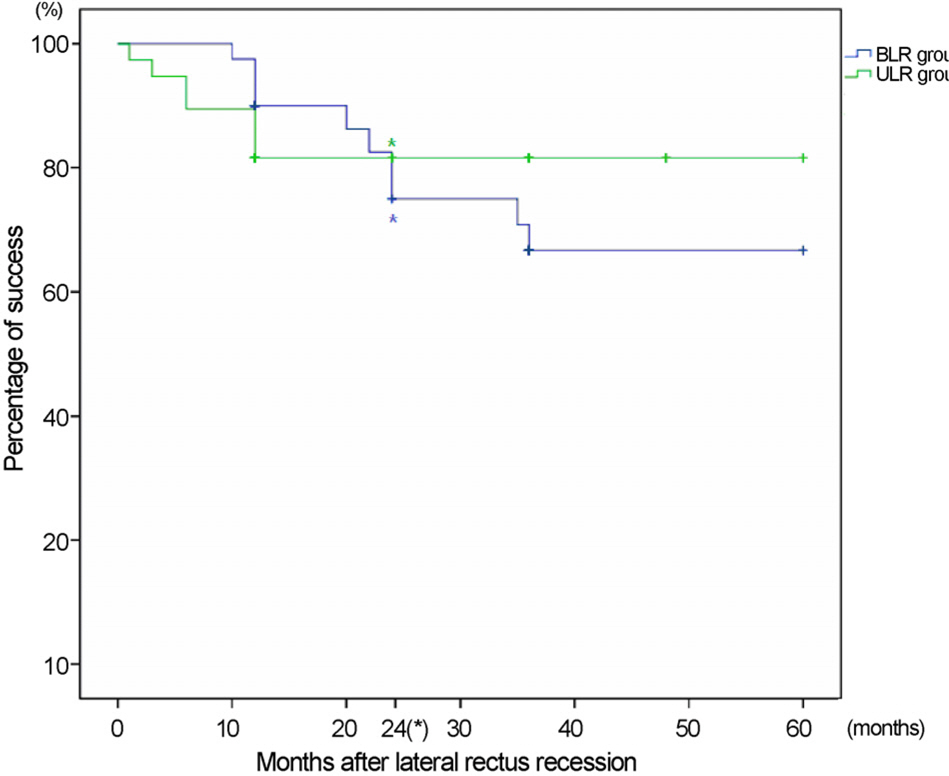J Korean Ophthalmol Soc.
2016 Dec;57(12):1926-1931. 10.3341/jkos.2016.57.12.1926.
Postoperative Exodrift Patterns after Bilateral or Unilateral Lateral Rectus Recession in 20 Prism-diopter Intermittent Exotropia
- Affiliations
-
- 1Department of Ophthalmology, Gachon University Gil Medical Center, Incheon, Korea. hjpaik@gilhospital.com
- KMID: 2362711
- DOI: http://doi.org/10.3341/jkos.2016.57.12.1926
Abstract
- PURPOSE
In the present study, the surgical outcome and postoperative exodrift pattern between bilateral lateral rectus recession (BLR) and unilateral lateral rectus recession (ULR) in intermittent exotropia of 20 prism diopters (PDs) were compared.
METHODS
In this retrospective study, 5.0 mm BLR or 8.5 mm ULR was performed on 82 patients for the treatment of intermittent exotropia of 20 PDs with a follow-up period of 2 years. The main outcome measures were postoperative 1-week, 1-month, 6-month, 1-year and 2-year exodeviation angles with their patterns and success rates. A surgical success was considered an alignment within 10 PDs and sensory success was defined at 100 seconds of arc.
RESULTS
The mean deviation angles at postoperative 1 week were 4.7 ± 5.1 PD esodeviation in the BLR group (44 patients) and 1.2 ± 4.2 PD esodeviation in the ULR group (38 patients). The BLR group was significantly more overcorrected than the ULR group (p = 0.001), but postoperative exodrift occurred in the BLR group at 1 week, 1 month, 6 months, 1 year, and 2 years. In the ULR group, the postoperative exodrift occurred at 1 week, 1 month, and 6 months which was followed by stabilized alignment. Surgical success rate at the postoperative 2-year follow-up was 75.0% in the BLR group and 81.6% in ULR group (p = 0.717).
CONCLUSIONS
ULR showed less overcorrection and early exodrift up to only 6 months, resulting in stabilization of the alignment afterwards; surgical success rate at the final 2-year follow-up was similar to BLR.
Keyword
MeSH Terms
Figure
Reference
-
References
1. Kim HJ, Kim D, Choi DG. abdominal outcomes of unilateral abdominal rectus recession versus recess-resect for intermittent exotropia of 20–25 prism diopters. BMC Ophthalmol. 2014; 14:46.
Article2. Peyman GA, Sanders DR, Goldberg MF. Principles and Practice of Ophthalmology. 1st ed.Philadelphia: Philadelphia;1980. p. 1846–9.3. Deutsch JA, Nelson LB, Sheppard RW, Burke MJ. Unilateral abdominal recession for the treatment of exotropia. Ann Ophthalmol. 1992; 24:111–3.4. Nelson LB, Bacal DA, Burke MJ. An alternative approach to the surgical management of exotropia-the unilateral lateral rectus recession. J Pediatr Ophthalmol Strabismus. 1992; 29:357–60.
Article5. Reynolds JD, Hiles DA. Single lateral rectus muscle recession for small angle exotropia. Strabismus. 1984; 2:247–53.6. Olitsky SE. Early and late postoperative alignment following abdominal lateral rectus recession for intermittent exotropia. J Pediatr Ophthalmol Strabismus. 1998; 35:146–8.7. Feretis D, Mela E, Vasilopoulos G. Excessive single lateral rectus muscle recession in the treatment of exotropia. J Pediatr Ophthalmol Strabismus. 1990; 27:315–6.8. Ryu JW, Lee SY, Lee YC. Result analysis according to surgical am-out after unilateral lateral rectus recession in patients with exoabdominal under 25PD. J Korean Ophthalmol Soc. 2006; 47:593–9.9. Hwang KY, Lee SY, Lee YC. Change of strabismus angle and abdominal after unilateral or bilateral lateral rectus recession in exotropia. J Korean Ophthalmol Soc. 2011; 52:60–6.10. Parks MM, Mitchell PR. Concomitant exodeviations. Duane TD, Jaeger EA, editors. Clinical Ophthalmology. Philadelphia: Harper & Row;1987. 1:chap. 13.11. Calhoun JH, Nelson LB, Harley RD. Atlas of Pediatric Ophthalmic Surgery. Philadelphia: WB Saunders;1987. p. 7.12. Menon V, Singla MA, Saxena R, Phulijele S. Comparative study of unilateral and bilateral surgery in moderate exotropia. J Pediatr Ophthalmol Strabismus. 2010; 47:288–91.
Article13. Weakley DR Jr, Stager DR. Unilateral lateral rectus recessions in exotropia. Ophthalmic Surg. 1993; 24:458–60.
Article14. Lee SN, Shin DB, Xu YG, Min BM. Effect of unilateral lateral abdominal recession for intermittent exotropia under 25 PD. J Korean Ophthalmol Soc. 2002; 43:1469–73.15. Cho HJ, Ma YR, Park YG. Comparison of surgical results between bilateral and unilateral lateral rectus recession in20–25 prism abdominal intermittent exotropia. J Korean Ophthalmol Soc. 2002; 43:1993–9.16. Sul CY, Park C. Large recession of one lateral rectus muscle for moderate-angle exotropia. J Korean Ophthalmol Soc. 1988; 29:125–9.17. Park KH, Kim SY. Clinical characteristics of patients that experience different rates of exodrift after strabismus surgery for abdominal exotropia and the effect of the rate of exodrift on final abdominal alignment. J AAPOS. 2013; 17:54–8.18. Park HG, Paik HJ. Comparison of surgical results between bilateral recession and unilateral resection-recession in intermittent exotropia. J Korean Ophthalmol Soc. 2003; 44:911–6.19. Shin KH, Wi JM, Paik HJ. The long-term outcome of lateral rectus advancement in patients with consecutive esotropia following abdominal lateral rectus recession for intermittent exotropia. J Korean Ophthalmol Soc. 2014; 55:1180–6.
- Full Text Links
- Actions
-
Cited
- CITED
-
- Close
- Share
- Similar articles
-
- Comparison of Surgical Results between Bilateral and Unilateral Lateral Rectus Recession in 20~25 Prism Diopters Intermittent Exotropia
- The Clinical Analysis of Surgical Methods in Intermittent Exotropia
- Comparison of Surgical Results Between Bilateral Recession and Unilateral Resection-Recession in Intermittent Exotropia
- Surgical Results of Unilateral and Bilateral Lateral Rectus Recessions in Exotropia under 25 Prism Diopter
- Surgical Results in Basic Exotropia of Moderate Degree


